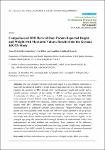Comparison of BMI Derived from Parent-Reported Height and Weight with Measured Values: Results from the German KiGGS Study
Brettschneider, Anna-Kristin
Ellert, Ute
Rosario, Angelika Schaffrath
The use of parent-reported height and weight is a cost-efficient instrument to assess the prevalence of children’s weight status in large-scale surveys. This study aimed to examine the accuracy of BMI derived from parent-reported height and weight and to identify potential predictors of the validity of BMI derived from parent-reported data. A subsample of children aged 2–17 years (n = 9,187) was taken from the 2003–2006 cross-sectional German KiGGS study. Parent-reported and measured height and weight were collected and BMI was calculated. Besides descriptive analysis, linear regression models with BMI difference and logistic regression models with weight status misclassification as dependent variables were calculated. Height differences varied by gender and were generally small. Weight and BMI were under-reported in all age groups, the under-reporting getting stronger with increasing age. Overall, the proportion for overweight and obesity based on parental and measured reports differed slightly. In the youngest age group, the proportion of overweight children was overestimated, while it was underestimated for older children and adolescents. Main predictors of the difference between parent reported and measured values were age, gender, weight status and parents’ perception of the child’s weight. In summary, the exclusive use of uncorrected parental reports for assessment of prevalence rates of weight status is not recommended.
No license information

